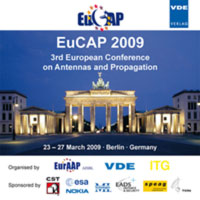Four-Beam Reflect-Array Antenna for Mm-waves: Design and Tests in Far-Field and Near-Field Ranges
Conference: EuCAP 2009 - 3rd European Conference on Antennas and Propagation
03/23/2009 - 03/27/2009 at Berlin, Germany
Proceedings: EuCAP 2009
Pages: 4Language: englishTyp: PDF
Personal VDE Members are entitled to a 10% discount on this title
Authors:
Lanteri, Jérôme; Migliaccio, Claire (LEAT, Laboratoire d’Electronique Antennes et Télécommunications, 250 Rue Albert Einstein, 06560 Valbonne, France)
Ala-Laurinaho, Juha; Vaaja, Matti; Mallat, Juha; Räisänen, Antti V. (MilliLab, SMARAD, Dept. of Radio Science and Engineering, TKK Helsinki University of Technology, P.O. Box 3000, 02015 TKK, Finland)
Abstract:
Millimetre-wave antennas have been of increasing interest with the development of radars for civil applications like automotive cruise control or helicopter crash avoidance. These systems require an antenna with high gain, low side lobes, and low profile. Printed reflectors or reflect-arrays have become the best solutions instead of parabolic reflectors or lenses, due to their low cost, low profile and fabrication facilities. The possibility to have multi-beam or scanning antennas is of importance in order to match the increasingly complex requirements assigned to the radars. During ACE-2 (Antenna Centre of Excellence, the second period of the EU funded virtual centre of excellence), δ projects between participating partners were promoted. In this context, LEAT and TKK decided to co-operate in the field of millimetre wave antenna measurement techniques. The antenna designed at LEAT is a reflect-array with large aperture area in wavelengths. Thus, the tests of the antenna in a far-field range require a large separation between the antenna-under-test (AUT) and the test antenna, which is challenging to accomplish indoors and LEAT does not have such facility available. Furthermore, the antenna has been designed with four simultaneous beams in various directions. This arrangement makes the radiation pattern measurements more sensitive to mechanical misalignments. However, TKK has planar near-field scanning capabilities for millimetre waves, and the reflect-array antenna was measured in the near-field range at the frequency range of 92–96 GHz at TKK during spring 2008.


